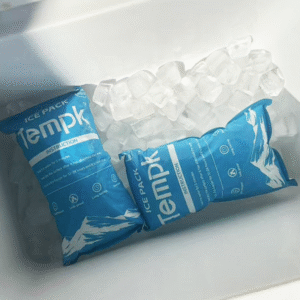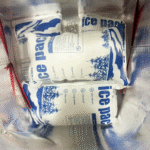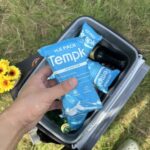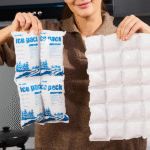Hojas de hielo seco versus ladrillos de hielo seco: ¿Cuál debería elegir para el envío??
El envío de productos sensibles a la temperatura requiere una cuidadosa consideración de los métodos de enfriamiento., especialmente cuando se usa hielo seco. Comprender las diferencias clave entre Hojas de paquete de hielo seco y ladrillos de hielo seco Es crucial para las empresas que dependen de estos productos para mantener la integridad de sus mercancías durante el tránsito.. Este artículo profundiza en las características, ventajas, y desafíos de cada solución de refrigeración, ayudándole a elegir el mejor según sus necesidades de envío específicas.
-
Comprender las diferencias clave entre láminas de hielo seco y ladrillos de hielo seco, incluyendo su eficiencia de enfriamiento y mantenimiento de la temperatura.
-
Aprenda las mejores prácticas para embalaje y envío con hielo seco, siguiente 2025 regulations and guidelines.
-
Make informed decisions about which dry ice solution suits your industry, si estás enviando comida, productos farmaceuticos, o muestras de laboratorio.
What Are Dry Ice Pack Sheets and Dry Ice Bricks?
Dry ice comes in two primary forms: Hojas de paquete de hielo seco y ladrillos de hielo seco. Both are designed to maintain low temperatures, but they offer different benefits depending on the nature of the shipment.
Hojas de paquete de hielo seco
Las hojas de paquete de hielo seco son flexibles, thin sheets of dry ice that are often gel-based. These sheets are ideal for smaller, space-efficient shipments that require controlled cooling but not freezing temperatures. These are commonly used for food, productos farmaceuticos, and medical devices that need to stay between 2°C and 8°C.
Ladrillos de hielo seco
Por otro lado, ladrillos de hielo seco are solid blocks of carbon dioxide. They sublimate more slowly and maintain a consistent, ultra-low temperature of -78.5°C. These are perfect for long-duration shipments or items that require congelación, como alimentos congelados, vacunas, y biológicos.
Beneficios del hielo seco:
1. Enfriamiento eficiente
Dry ice absorbs heat and maintains a stable, ambiente frio. Whether in sheet or block form, it’s designed to preserve temperature-sensitive goods durante el tránsito.
2. Sin residuos líquidos
A diferencia del hielo tradicional, El hielo seco no se derrite en el agua. This means there’s no hay lío, making it a preferred option for shipping items like carne, mariscos, y productos farmacéuticos.
3. Rentable
While dry ice might seem more expensive at first glance, its ability to maintain temperature over long periods helps businesses avoid costly product spoilage.
Why Choose Dry Ice Bricks or Pack Sheets?
For Long Shipments: Ladrillos de hielo seco
Ladrillos de hielo secos oferta duraciones de enfriamiento más largas due to their slower sublimation rate. They’re ideal for envíos de larga distancia, particularly when productos congelados need to be kept at consistently low temperatures for up to 5 días.
-
Rango de temperatura: −78.5 ° C
-
Duración del enfriamiento: 72–120 horas
-
Aplicaciones: Vacunas, biológicos, comida congelada
For Shorter, Space-Sensitive Shipments: Hojas de paquete de hielo seco
hielo seco empacar hojas are often more flexible and rentable. They’re perfect for smaller shipments or those requiring enfriado temperatures without reaching freezing.
-
Rango de temperatura: 2°C a 8°C
-
Duración del enfriamiento: 24–48 horas
-
Aplicaciones: Productos farmacéuticos, comida fresca, productos cosméticos
A Side-by-Side Comparison
| Solución de enfriamiento | Rango de temperatura | Duración del enfriamiento | Caso de uso |
|---|---|---|---|
| Hojas de paquete de hielo seco (Gel) | 2°C a 8°C | 24–48 horas | Productos farmacéuticos, comida refrigerada, kits de comida |
| Ladrillos de hielo seco (Co₂ sólido) | −78.5 ° C | 72–120 horas | comida congelada, biológicos, vacunas |
¿Cuál es mejor para su envío??
Elegir entre Hojas de paquete de hielo seco y ladrillos de hielo seco depende de varios factores:
-
Duración del envío: Para envíos más largos, dry ice bricks are the better option. They provide extended cooling, making them perfect for multi-day shipments.
-
Tamaño del envío: Dry ice pack sheets are ideal for compact shipments where space is a concern.
-
Presupuesto: Dry ice pack sheets are more rentable compared to bricks, making them a good choice for menor, less time-sensitive shipments.
Best Practices for Safe and Efficient Dry Ice Shipping
Proper packaging and handling are critical when shipping with dry ice. Here are some essential best practices to ensure your dry ice performs optimally:
1. Packaging Guidelines
-
Use contenedores aislados: Always pack dry ice in well-insulated boxes to reduce heat transfer and prolong cooling.
-
Asegurar la ventilación: El hielo seco se sublima en gas dióxido de carbono, que puede causar acumulación de presión if trapped inside an airtight container. Deje siempre las rejillas de ventilación abiertas o utilice envases con ventilación para permitir que el gas escape de forma segura..
2. Etiquetado y Documentación
-
Etiquetas de peligro adecuadas: El hielo seco se clasifica como un Material Peligroso por la ONU. Utilice el etiquetado correcto, incluyendo el “Dióxido de Carbono, Etiqueta sólida” y Número UN1845.
-
Trámites de envío: Asegúrese de que los documentos de envío reflejen con precisión la cantidad de hielo seco e incluyan las instrucciones de manipulación adecuadas..
3. Pautas de peso y cantidad
-
Límites de envío: La cantidad máxima de hielo seco por envío generalmente es 5.5 libras (2.5 kilos), con documentación adicional requerida para envíos más grandes.
-
Calcule las necesidades de hielo seco: Para envíos de corta duración, planea usar 0.5× el peso del producto en hielo seco. Para envíos más largos, aumentar la cantidad basado en la duración del enfriamiento.
2025 Tendencias en el envío de hielo seco
Mientras miramos hacia 2025, La industria del transporte de hielo seco está evolucionando para satisfacer la creciente demanda de sostenibilidad y integración tecnológica:
Embalaje sostenible
Muchas empresas son invertir en bolsas de hielo seco reutilizables y embalaje ecológico Soluciones para reducir su huella de carbono.. Esta tendencia se alinea con el creciente enfoque en la responsabilidad ambiental..
Sensores inteligentes para monitoreo en tiempo real
Avances en embalaje inteligente permitir en tiempo real monitoreo de temperatura, Garantizar que las mercancías sensibles a la temperatura permanezcan dentro del rango deseado durante el tránsito..
Sistemas de reciclaje de circuito cerrado
Algunas empresas han adoptado sistemas de reciclaje de hielo seco de circuito cerrado, Permitir que el hielo seco se reutilice varias veces., Reducción de residuos y reducción de costes..
Preguntas frecuentes
Q1: ¿Cómo calculo la cantidad de hielo seco para mi envío??
Para 24-envíos por horas, usar 0.5× el peso del producto en hielo seco. Para 48-envíos por horas, Haga coincidir el peso del hielo seco con el peso del producto..
Q2: ¿Se puede utilizar hielo seco para envíos internacionales??
Sí, pero asegúrese de cumplir con regulaciones internacionales y garantizar la documentación adecuada para cada país..
Q3: ¿Cuánto tiempo puede el hielo seco mantener una temperatura fría??
Los ladrillos de hielo seco pueden mantener temperaturas ultrabajas durante hasta 120 horas, mientras que las láminas de hielo seco pueden durar 24-48 horas dependiendo de las condiciones.
Conclusión: Elegir la solución de hielo seco adecuada
Selecting the appropriate dry ice solution—Hojas de paquete de hielo seco o ladrillos de hielo seco—depends on your product’s temperature requirements, Duración de envío, y presupuesto. By following the best practices outlined in this article and staying informed about the latest trends in dry ice shipping, you can ensure the safe and efficient transport of your temperature-sensitive products.
Próximos pasos para su negocio:
-
Review your shipping protocols to determine which dry ice solution fits your needs.
-
Garantizar el cumplimiento de 2025 regulaciones regarding packaging, etiquetado, y documentación.
-
Partner with logistics experts to optimize your cold chain and reduce spoilage risks.
Acerca de Tempk
Tempk specializes in providing Soluciones de cadena de frío de última generación tailored to your shipping needs. From dry ice products to advanced logistics systems, we ensure your temperature-sensitive goods reach their destination safely and efficiently. Contáctenos hoy para una consulta sobre cómo optimizar sus soluciones de cadena de frío.
























